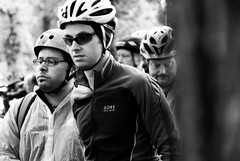
Ride of Silence was a solemn affair.
Full gallery here
(All photos © J. Maus)
About 70 Portlanders took part in the Ride of Silence last night.
After a brief speech by BTA executive director Scott Bricker, the crowd rode from the North Park Blocks, made a loop through downtown, went over the Broadway Bridge, then up MLK Jr. Blvd., and ended at N. Interstate and Greeley.
The ride was solemn and silent (except for the occassional chime of bike bells) and riders pinned signs on their bikes and bags that read “share the road” and “remembering fallen cyclists”. We rode through the streets with a full police escort, unencumbered by the hassles or molestations of motor vehicle traffic.
Along the way, we passed by the memorial ghost bike for Tracey Sparling — the 19 year-old art student who lost her life after a truck turned into her path at W. Burnside and 14th last year.
Though Tracey was not an avid cyclist herself, her family has come to appreciate the support shown to them by Portland’s bike community. Joining the ride last night was Tracey’s aunt Susie Kubota, her husband Jim Lundblad, and Tracey’s mom and dad, Lee and Sophie Sparling (Sophie rode in a pedicab).
When I got home from the ride, I found an email from Susie Kubota in my inbox. She expressed her family’s gratitude for the education and information they’ve received in part by following the thoughtful dialogue in the comments of this site since their daughter was taken from them.
She also shared why the whole family joined us on the ride:
“The Ride of Silence is a memorial ride, and a ride for awareness, so our family rode tonight to remind everyone of our precious Tracey. We rode tonight because we have been overwhelmed by the empathy and kindness we have received from the cycling community during our tragic time of sorrow.
It was sobering but comforting to travel with others contemplating the memories of Tracey and other riders killed or injured while cycling the very streets we were riding.”
When we passed the site of Tracey’s untimely death, Kubota stopped to lay down fresh flowers. It was a powerful moment.
The ride also passed through the site on MLK Jr. Blvd. where Chris Burris lost his life in September of 2005 and it ended at the fateful intersection of N. Interstate and Greeley, where Brett Jarolimek was killed just weeks after the Tracey Sparling tragedy.
In Beaverton, 18 riders gathered at the Beaverton Library to participate on the 2nd Annual Westside Ride of Silence. According to ride participant Jim Parsons (K’Tesh in the forums), all riders were given black armbands before their six mile ride, which passed by several ghost bikes.
The Portland ride was covered by several local media outlets including the Oregonian, and TV crews from KATU, KGW, and FOX.






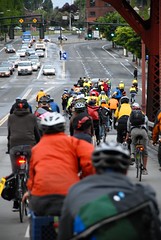
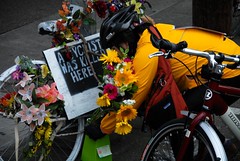

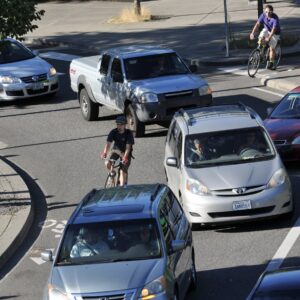
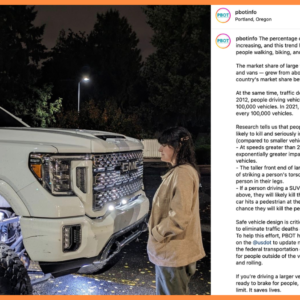
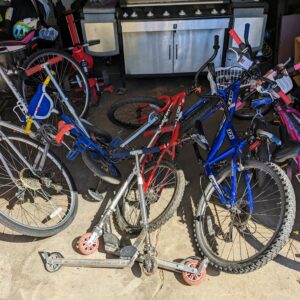
Thanks for reading.
BikePortland has served this community with independent community journalism since 2005. We rely on subscriptions from readers like you to survive. Your financial support is vital in keeping this valuable resource alive and well.
Please subscribe today to strengthen and expand our work.
It was a great ride. The professional police escort was quite a spectacle and very appreciated on my part.
That\’s me lending a hand to the pedicab on the port side. Oooofta. I had no idea who the passenger was at the time.
Double oofta: No, that\’s not me in the pic, but I did help push up the Broadway Bridge approach.
I missed the ride last night due to another commitment.
Peace and comfort to all the families of those lost, and to the fallen – may your ride be smooth, the wind at your back, and pleasant vistas abounding.
I can\’t read about something like this without getting tears. Please everybody, be as careful as you can be out there!
Despite day-of plans to attend this most important event, I realized on my ride home from work that I was coming down with a cold. Whereas I so wanted to go, my muscles did not, so I stayed in.
To Susie, Dayn, and other friends who have been coping with and healing from these losses:
Please know that I think of your loved ones as I ride through town each day. Know that, in doing so, I also think about you. I am amazed and inspired by your incredible strength, compassion, and willingness to turn something terrible into an opportunity to help protect others. Thank you all that you do, and know that we in the community will always be here in your corner, supporting you however possible.
You are in my thoughts, and I am so very sorry that I missed the ride. I very much wanted to be there, as you know.
With warmth, encouragement, and support for all coping with tragic losses that occur on the road,
Erin
‘We are ALL Traffic’
I\’m actually a bit surprised by the group size for this. I would have expected it to be much higher in Portland.
Our ride had 28 riders in a town of only 20,000 people. It was still pretty amazing and I think this event is much better received than a Critical Mass ride.
If you click my name you can see the coverage of our little group.
According to AAA, 43,000 Americans die EVERY year because of motor vehicle crashes. Year-in, year-out, 2 Oregonians die from motor vehicle crashes EVERY day. With all DUE respect to the family, where\’s the Drive of Silence for dead motorists?
I think it\’s far more respectful to the memory of dead motorists, not to mention dead cyclists and pedestrians, to keep cars parked. I sense no due respect in this comment whatsoever.
Jonathan, I couldn\’t find coverage on the KATU, KGW, or KPTV web sites. If you have links, could you post them?
I saw the motorcycle police downtown on my way to an appointment, otherwise would have stayed here for the Beaverton ride. Was touched to see Mike\’s ghost bike the other morning.
Bradly – very nice article on the Sedalia, Missouri ride, by the way.
@ #7 BikeBillboards dot blogspot dot com:
Any tragedy can be one-upped by some other tragedy that is larger in scale. Motor vehicle accidents kill more people than bike accidents. Well, genocide kills more people than motor vehicle accidents. It doesn\’t mean that any of them are not tragedies that deserve attention and/or commemoration. If you feel like victims of motor vehicle accidents should be honored with a Drive of Silence (and I\’m not saying they shouldn\’t be), then you should make it happen. But don\’t belittle the Ride of Silence in the meantime. The bike community organized a ride for fallen bikers — what\’s wrong with that?
To #7: We\’re bikey sorts. We organized the Ride of Silence.
I encourage you to contact the appropriate city officials, help create positive change, and push to organize a Drive of Silence.
Having drivers gain even more awareness of the number of deaths caused by motor vehicles can only help the roadways become safer for all.
I don\’t know what existing motor vehicle sort of organization you could contact to help spearhead such an effort. Such a group would be appropriate for directing your question.
Let\’s keep this all in perspective for the cycling community. If you want to start a motor vehicle commuting blog #17 then go ahead. There must be a ton of positives to write about…global warming issues, drinking and driving fatalities, road rage incidents, insurance nightmares- the list is endless. I too missed the ride last night, just wasn\’t able to plan ahead of hearing about it the same day. Is this an annual event, or spur of the moment?
I am at unease with Ride of Silence. The raw number of bike deaths are proportionately small. Everybody knows the consequences of a bike/car meetup.
That\’s precisely why EVERYBODY tries desperately to avoid them. So, why blow the statistically occasional bike/car meetup all out of proportion?
#13: Don\’t like it? Don\’t ride it. This is an effort to honor our dead. Bike centric? Yes, it\’s a bike community. We\’re not here to vilify drivers or discount anyone else\’s loss. Please do not discount ours. Your last post suggests that because bike death is rare, it is unimportant. I suspect Tracey Sparling\’s family feels differently. I suggest you reread #10 and 11 and take appropriate action if you are so moved.
I was unable to participate in the ride myself. Thanks Jonathan for the coverage and photographs. Thanks also to everyone who was there.
BikeBillboards:
How does having a memorial ride blow anything out of proportion? People are allowed to commemorate any tragedy they like, large or small, regardless of the number of affected individuals. In doing so, it provides an outlet for those who were affected by the event, and it may raise awareness for others. But I fail to see why a memorial ride is a bad thing or how it blows anything out of proportion simply by taking place.
There are countless organizations for children born with rare diseases that provide support to affected families and raise awareness, similar to the way that this ride raises awareness and provides support. What is your threshold for the number of people who must be affected before it is \”okay\” to have a ride, or a 5K, or some other public event on behalf of those people?
To #13: Thank you for sharing your unease with the Ride of Silence.
Could you please share the numbers to illustrate the \”statistically occasional bike/car meetups\” and how the Ride of Silence blows these \”out of proportion\”.
In particular, please indicate the yearly total number of bicyclist deaths from collision with motor vehicles and the yearly total number of bicycle miles ridden – perhaps provide these figures for Portland for each year over the past decade. Also please give the yearly total number of motor vehicle deaths from collision with any other vehicle and the yearly total number of motor vehicle miles driven – again for Portland for each year over the past decade. Please state your sources for this data.
This should provide a good start for ascertaining whether or not anything is being \”blown…out of proportion\”. Once this is established, one might be able to answer the \”Why\” you asked, if the numbers suggest that your question still makes sense.
@ #10 DT:
\”…genocide kills more people than motor vehicle accidents.\”
Not true. You\’re underestimating how deadly motor vehicle accidents are. According to the World Heath Organization, road crashes kill 1.5 million people each year and injure 50 million. By comparison, the Rwandan Genocide in 1994 killed 800,000. That number is eclipsed by a just a few months carnage on the world\’s roads.
Few people seem to appreciate how deadly automobiles are. Cars kill and maim more people than guns, wars, terrorism, air crashes, or just about anything else.
\”Everyone knows the consequences of a bike/car meet-up.\”
The fact that someone would qualify a horrible collision that takes someone\’s life as a \’meetup\’ speaks clearly to his intent to downplay those deaths. If everyone knows the consequences, do they UNDERSTAND the consequences? And if they do understand, and people like Tracy still die in the face of that understanding, doesn\’t that imply that drivers who end up taking the life of cyclists (in such cases when it is the driver\’s fault) are doing so with some kind of intention? I don\’t think that\’s the case, necessarily. I think many people drive in a way that is both selfish and careless. \”Me first. My car belongs here, you and your bicycle don\’t. Text-messaging my friend was more important to me than keeping my eyes on the road.\” One bicyclist death per year is too much, and it\’s clear that people need to be reminded of why it keeps happening. I agree that the 43,000 people who die every year in the US because of car collisions is way over the top and completely not acceptable. I think most of the members of the community who read this site acknowledge that fact every day they choose to ride instead of drive. I hope I can live out the remainder of my years never harming another person (or a kitty! or a squirrel!), with a car or otherwise. The one thing I can do every day to achieve that is to not use objects that can cause harm to people. I don\’t play with guns, I don\’t make pipe bombs in my basement, and I don\’t put myself in a driver\’s seat very often, and never while impaired. Those are all choices people make that can lead to horrible \”accidents.\”
@ #17 JDL
Okay, so I will admit to not researching that statement. I chose an example of a mass tragedy to illustrate my point, but you are correct that I did not go and look up the actual figures.
That said (and I don\’t mind that you called me out on it), I will stand by my point that most awful events that happen can be eclipsed by other, even more awful events, no matter what it is. And in this case, BikeBillboards seemed to be using Numbers as \”that which determines significance.\”
Again, I am not belittling the death of anyone, especially a fellow bicycle driver.
As a bike billboard driver, I am in and out of traffic, EIGHT hours a day, EVERYDAY. I put advertising messages in front of motorists. Of course, my clients and I get a whole lotta FLACK.
Some of the flack is actually INTENDED. Depending on the message and campaign, we want ANGRY, ignorant motorists to call the cops, and the talk radio stations to out their IGNORANCE.
What I see RoS doing is perpetuating the myth that bicycle driving in traffic is so dangerous that cops, the courts, and the transportation planners must go out of their way to \”protect\” bicycle drivers.
Would vested interests in the automobile industry do a national Drive of Silence? I doubt it. So, why should the bicycle community, seeking to encourage MORE bicycling, do RoS?
The Insurance Institute seems to have a much more productive approach to preventing motor vehicle deaths. Perhaps we should take notes?
To #20: You used the word \’myth\’. I asked you for statistics (see #16). Still waiting…
You are entitled to your opinion. But your first post asked about the lack of a Drive of Silence (a great idea!), and your last post seems to suggest you really are not behind that idea. Why the first post, then? If you are trying to express your opinion, you seem to be going about it in a rather indirect manner.
Thanks to the organizers for organizing, and to the riders for riding. I, too, had a schedule conflict and wasn\’t able to join the ride.
It\’s a testament to how great the bike community is that we can care so much about total strangers that we join their friends and families in honoring the lives they lived. I\’m ever so thankful that I don\’t personally know any fallen cyclists, and I cannot (and do not want to) imagine the pain of having a loved one die this way. My heart goes out to those friends and families.
Perhaps I\’m fanning the flames of the already-overheated ongoing dispute with (s)he-who-will-not-be-named, but the great thing about getting around by bike is that you get to be a human, and it\’s so easy to meet and talk with the other humans (other cyclists and pedestrians) when you encounter them. When you\’re in a car, you\’re an anonymous metal box divorced from your surroundings. You only become a human again when you leave the car. So of course there would be no \”Drive of Silence\” — who wants to honor anonymous metal boxes? Those drivers who died in crashes get honored in other, more humane ways.
This ride was not just about bicylist – in the opening remarks, Scott stated that 43,000 people die on our roads every year. Most of those are motorists. The point is, everyone needs to be more careful and attentive while driving and riding. We can all prevent tragedies by being aware of EVERYBODY on the road.
Last night, we honored fallen cyclist – by extension we honored all users of the roads.
Barbara
Saw two more ghost bikes tonight in Beaverton. Thanks to the city people who are allowing these during bike month. For one, it helps educate both cyclists and motorists where the dangerous locations are, as well as force some drivers to ask about them and raise awareness.
BikeBillboards, I see your viewpoint, though wouldn\’t say RoS blows it out of proportion. Those who fear cycling are going to do so with media coverage; I doubt this pushes them off the fence. If you pro-rate the numbers cycling deaths aren\’t terribly lower than auto deaths, taking into consideration each \”meetup\” has the propensity to kill one bike passenger whereas cars carry one to seven passengers, let alone the number of drivers and time or miles driven being orders of magnitude higher.
I disagree that it\’s a myth that planners and enforcers must go out of their way to protect either cyclists or pedestrians, because they truly must. It\’s not just a matter of education, as you say, but of legislature, enforcement, infrastructure, even physics. Bikes and peds and cars are indeed different, so without tools like crosswalks, speed zones, lights and signage, and I daresay bike lanes, pedestrian and cyclist deaths would be much higher than they are. The very existence of many of these tools is borne of that fact.
I agree with your statement that the Insurance Institute has productive approaches to auto safety (see my comment in the helmet law article), but I don\’t think that\’s relevant here. Them organizing a Drive of Silence doesn\’t offer the cost/benefit ratio a targeted ad campaign does, or a political lobby to mandate seat belts, air bags, and (the latest push) electronic suspension. For a cycling community, an organized ride seems a pretty good bang for the buck.
The \”Share the Road\” aspect of this campaign is not unlike your own, but as participants we also pay tribute to our family and friends, not unlike Memorial Day ceremonies honor fallen family and friends who died in service to our country.
I missed the ride. Me and my wife delivered a meal to a family of a cyclist who was run down by a drunk driver 2 weeks ago in PDX
let\’s talk lesson the iinternet and do more.
http://www.lotsahelpinghands.com/c/604593/
There is nice core group of activists who setup ghost bikes.
I want to start a core of people who help the living victims of car attacks in PDX. Starting with pedestrian and bike victims. Call me or email
joe rowe 503. 282. 7693
or jrowe (at)) igc.org
#24, Pete wrote:
\”Bikes and peds and cars are indeed different, so without tools like crosswalks, speed zones, lights and signage, and I daresay bike lanes, pedestrian and cyclist deaths would be much higher than they are. The very existence of many of these tools is borne of that fact.\”
There is something to be said about using CONFUSION as a traffic control device.
Ah, a forced VC approach. For a German town of 13,000 with a speed limit of 30 MPH this might work. In the city I live (Hood River) the population is ~6000, though it is growing and swells with tourists in the summer. The Heights area is an example of this, where a speed limit of 25 is enforced and cyclists are forced onto the 4-lane road, pedestrians in some spots. Before they painted and signaled a crosswalk, there were ~3 peds killed per year, now there are none. There was a housing tract built that caused numerous accidents at one intersection (where they are also now building a community college). They added a traffic light three years ago and accidents are nearly nonexistent there now (given also the speed is only 25 and highly enforced by bored cops). Is it a confusing area to drive or even cycle on? Far from.
I appreciate the article, though, and I also appreciate your counterpoints. It takes courage to say what the majority will take a stand against, but that\’s how we learn. Thank you.
As bike billboard drivers, part of our survival technique is causing CONFUSION. When motorists are confused, they SLOW down. Problem SOLVED.
Human nature as it relates to traffic is the same in Germany as it is in Hood River. Maybe the Germans will go back to traditional traffic control devices.